steveintoronto
Superstar
^ @Northern Light : You came up with that in perhaps ten minutes of searching, and Verster hasn't a clue on it. There's a reason that "deep tunnels" were chosen for the DRL. The soil conditions and underlying shale demanded it. Shallow tunnelling isn't possible, and cut and cover is out of the question for both geologic and social reasons. Not only that, recent advancements in TBM tech have slashed the cost of deep tunnelling. It's not the tunnelling itself that's the expensive part, once you have an operation supported and serviced, you might as well tunnel (cutter wear permitting) until the machine is spent. It is now cheaper in most instances to abandon the TBM in situ (or run it off to one side) than to try and recover them. Heads are usually replaced once the tunnel section breaks into a station box. That's the greatest wear demand, and even there, the tech for cutting heads keeps improving.
Verster should know all of this. If he does, he's being a liar saying what he is. If he doesn't, he shouldn't hold the job he does. Btw, on station boxes, one of the most expensive parts of deep tunnelling, there's been some developments in just the last year or so to reduce the costs of that. Mostly due to vertical TBM techniques, but I'll detail that later.
Verster should know all of this. If he does, he's being a liar saying what he is. If he doesn't, he shouldn't hold the job he does. Btw, on station boxes, one of the most expensive parts of deep tunnelling, there's been some developments in just the last year or so to reduce the costs of that. Mostly due to vertical TBM techniques, but I'll detail that later.






